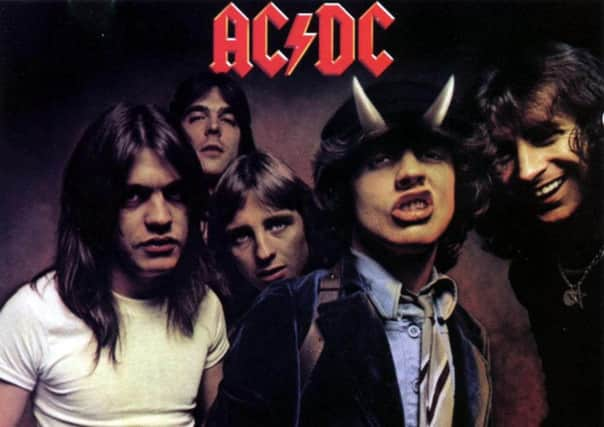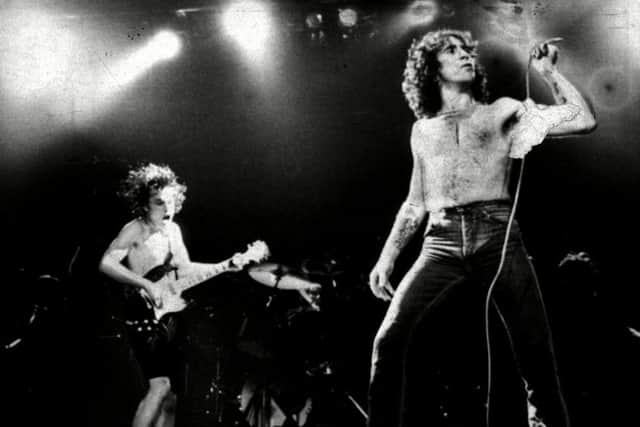Insight: Scotland's greatest ever rock band '“ we salute you


When the pupils of Glasgow’s Milncroft Primary used to gather for morning assembly, they sang a song which paid tribute to their seat of learning, and demonstrated how, even though they lived in a downtrodden post-war housing estate on the city’s eastern fringes, they had reason to be proud. “School that is set on the hill,” it began, before the volume ramped up and the children, en masse, sang: “WE SALUTE YOU!”
The ditty, like the school itself – demolished in 2005 – has long been consigned to history, its author lost in the mists of time. But those who passed through Milncroft’s classrooms held on to the memory, not least two brothers by the name of Angus and Malcolm Young, who left when they were aged just eight and ten.
Advertisement
Hide AdAdvertisement
Hide AdDecades later, as the driving force behind one of the world’s most popular bands, they sat down to write their eighth studio album. Ordinarily, their lyrics revelled in every cliché the pantheon of rock’n’roll has to offer, advocating a life well spent chasing drink, women, and adventure. This time, however, the creative process seemed to draw on the old Cranhill anthem. “For those about to rock,” their song began. “WE SALUTE YOU!”


Some may regard such a connection as a throwaway coincidence, but others who have spent time in company of the Youngs can attest to its significance. Tom Russell, the veteran disc jockey, has interviewed Angus, the band’s lead guitarist and co-founder, several times over the years. On each occasion, their conversation has always turned to home.
“I remember the first time I spoke with Angus I asked him what his memories of Glasgow were,” recalled Russell, a stalwart of Radio Clyde during the station’s halcyon years. “He lit up and explained that every time he thought of the city, he was running home from school and going to his bedroom. ‘I’d be staring out of the bedroom window supposed to be doing my homework,’ he said, ‘and all I’d see was a big water tower’.
“That was home to him and Malcolm and I think it still is. Any time the band were in Glasgow over the years, the brothers would always get a taxi before their gig and take a wee run around Cranhill, meeting up with their relatives.”
The origins of AC/DC have always made for fevered discussion among rock aficionados around the world, all of whom wish to stake a claim to a band that have sold more than 200 million albums, beating the likes of Frank Sinatra, Bruce Springsteen, U2, and The Eagles. Aurally, their taut, pulsing cacophony of sound is indebted to the Chicago blues movement made famous by Chess Records and, in particular, Chuck Berry. Officially, they are regarded as an Australian band on account of the fact the founding members met and spent their formative years there.


Yet such inconvenient truths have never prevented Scotland from claiming the group as its own. On the one hand, it is a simple matter of birthright. Angus and Malcolm may have been only eight and ten when they left Cranhill for Sydney in 1963 after their parents, William and Margaret, signed up for the Ten Pound Pom assisted package, but they have never forgotten where they come from.
Bon Scott, the band’s lead singer during its early glory days, was also proud of his Scottish roots. Born in Forfar, his parents, Chick and Isa, ran a bakery in Kirriemuir’s Bank Street, where they churned out plentiful supplies of the Angus town’s famous gingerbread. But like the Youngs, they were wooed by the promise of a fresh start Down Under.
Settling in the western port city of Fremantle, nine miles south of Perth, the young Bon joined the Fremantle Scots Pipe Band, where he played the bagpipes with aplomb. He would famously display his prowess on the pipes in the music video to 1975’s It’s A Long Way To The Top (If You Wanna Rock’n’Roll).
Advertisement
Hide AdAdvertisement
Hide AdThe links which stretch halfway around the world mean, in the eyes of many, that AC/DC are a Scottish act. “I don’t think there’s any doubt you can say AC/DC are Scotland’s most successful ever band,” said Russell. “Whenever I’ve interviewed big American bands early on in their career, like Aerosmith and Bon Jovi, they’ve been really excited to be in Glasgow simply because it’s where the Young brothers are from. They used to ask me where Angus lived and where he went to school.


“They’re a band Scotland should be proud of and celebrate, although I don’t think that’s been done enough over the years.”
The band’s remarkable journey from those early beginnings in Scotland to stadium-filling titans of rock is fastidiously chronicled in a new book due to be released this autumn.
High Voltage: The Life Of Angus Young is the first biography of AC/DC’s lead guitarist and only remaining original member. Its author, Jeff Apter, believes the story of the man he describes as the “face, sound and sometimes the exposed backside” of the band is worth telling in detail.
Young, perhaps best known for the schoolboy outfit he wears on stage, is a fiercely private individual who has cultivated a caricature persona, but at heart, Apter points out, he is a product of working-class Glasgow.


Indeed, the city features prominently in the book, with particular focus on the band’s live shows, the first of which took place in April 1976 before just 150 punters at the student union of the old Napier Technical College in Sighthill.
Three months later, after several other warm-up shows, the band embarked on its 19 date Lock Up Your Daughters tour of the UK. As Apter points out, it kicked off in Glasgow’s City Halls, which felt like a “homecoming” for the Young brothers and a “reminder of where they’d started out”.
With tickets priced at just 50 pence – stubs from the tour now fetch hundreds of pounds on online auction sites – Apter said that there were numerous familiar well-wishers on hand to greet the brothers on their triumphant return.
Advertisement
Hide AdAdvertisement
Hide Ad“To the others in the band, it seemed as though Young family members were coming out of the woodwork,” said Apter. “The backstage area at the City Halls was positively bursting with Angus and Malcolm’s relatives, all speaking with pea-soup-dense Glaswegian accents.”
But it was a concert two years later that would strengthen the bond between AC/DC and Glasgow, and in the process produce one of the most acclaimed live albums ever committed to record.
“I think that together with Thin Lizzy’s Live And Dangerous, AC/DC’s If You Want Blood You’ve Got It is one of the best rock concert records ever released,” reflects Russell, whose autobiography, The Godfather Of Rock, features several anecdotes about his interviews with AC/DC and bands such as Metallica and Iron Maiden.
“At the time, live albums did not always sound particularly live, with parts recorded in the studio and other parts dubbed on. But on AC/DC, you can hear the chants of every person in the crowd, it’s absolutely electric.”
The gig in question, which took place at Glasgow’s Apollo venue in April 1978, captured the band at their peak, with Scott in particular at his best, though at one point he is said to have run backstage to have a drink, only to take a wrong turn, ending up locked out on Renfield Lane while Young battered away at an extended solo.
Unusually, the show also saw AC/DC play an encore, with the band members returning to the stage wearing Scotland football strips. A video of the gig, which has never received a commercial release, was screened during an exhibition devoted to the band at Kelvingrove Art Gallery and Museum. The concert has, in short, become part of rock folklore.
“The Apollo held about 3,500 people, but I think over the past 40 years I’ve spoken to between 50,000 and 100,000 people who claimed they were there that night,” jokes Russell.
Young and his bandmates are only occasional visitors to Scotland these days, although Hampden is a regular stopping off point whenever one of their gruelling world tours grinds into motion. Such gatherings are considered special not only by the fans (their last show at the national stadium sold out in less than 60 minutes), but the band themselves.
Advertisement
Hide AdAdvertisement
Hide AdAt every Scottish concert, Young shakes up the set-list to perform a number entitled Fling Thing.
Originally recorded in 1976 as a B-side to their single Jailbreak, the track is based on the traditional ballad, The Bonnie Banks O’ Loch Lomond. Although the song is ostensibly a showcase for Young’s lead guitar skills, the appreciative Scottish crowds always provide accompanying vocals.
For all the props and pyrotechnics that feature in an AC/DC show, Russell believes the band’s success and longevity is down to old fashioned songcraft. “It’s the simplicity of AC/DC’s songs that makes them so popular,” he said. “They’re very well written, well sung, but never complicated. It’s just good rock and roll and you see that at its best when they’re played live.”
It has been two years since the band last visited Scotland and many fans now wonder if they will ever return. In 2014, Malcolm was forced to retire after being diagnosed with dementia. The same year, the band’s longstanding drummer, Phil Rudd, parted ways with the Youngs after a series of run-ins with the police over drug offences.
Last year, Brian Johnson, who replaced Scott as the vocalist after his death in 1980, left the band after doctors advised him he was in danger of going deaf, while bassist Cliff Williams retired after deciding the recent upheaval had left AC/DC a “changed animal”.
The succession of line-up changes, however, has not put paid to AC/DC’s future, nor its ties with Scotland. Malcolm’s replacement, Stevie Young, is not well-known, but when the band could have had its pick of some of the world’s best session guitarists, his hiring demonstrates the continued importance of the Young clan’s birthplace to the AC/DC story.
Stevie is the son of Stephen Young, Angus and Malcolm’s eldest brother, and was part of the family’s mass exodus to Australia in 1963. However, he and his parents only stayed there for a few years before deciding to come home again, and Stevie grew up in the Borders town of Hawick, where he enjoyed modest success in local groups such as The Stabbers, Prowler and Tantrum.
But whether Stevie gets the chance to again line up alongside his Uncle Angus is in doubt. No replacement for Williams has been announced, and it remains to be seen whether Axl Rose, the Guns N’ Roses singer who stood in for Johnson during the group’s Rock Or Bust world tour, will return.
Advertisement
Hide AdAdvertisement
Hide AdIn the meantime, Scottish fans must make do with the annual BonFest music festival, a popular event in Kirriemuir celebrating the life and career of Scott, and irregular appearances by veteran tribute acts such as Volts, Live Wire and Hells Bells. Such is the demand, some of the doppelgängers sell out 1,400 capacity venues.
While many fans hope the real deal will eventually return, Russell is of the view that after a 44-year run, Young, 62, should consider calling it a day.
“My personal feeling is that Angus should now say, ‘I’ve had a great career, I’ve got plenty of money in the bank, and I don’t need to do it any longer’. However, if he wants to do it, then it’s not my business to say he shouldn’t.”
Whatever the future holds, Russell believes Glasgow – and Scotland – could do more to recognise some of its most famous sons, perhaps with the help of the old water tower that loomed over Angus Young’s childhood home.
The structure still stands at the corner of Cranhill’s Stepps Road and Bellrock Street. Despite suggestions from some in the city council that the band’s logo – or at the very least its famous lightning bolt – could be painted on it, there is no permanent tribute to AC/DC in Glasgow.
“You walk through George Square in Glasgow, and there are some statues of politicians and generals that no one nowadays has ever heard of,” says Russell. “The Young brothers have done more for Glasgow and Scotland, so it would be fitting to see a statue of Angus doing the Chuck Berry duckwalk, maybe with a traffic cone on his head.”